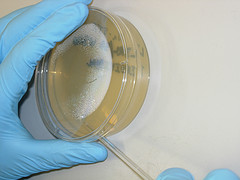
- Image by lofaesofa via Flickr
It has been possible to successfully cryopreserve semen, blood, embryos, oocytes, stem cells and other thin samples of small clumps of cells for a few decades now.
However, cryopreservation of human internal organs, such as livers and hearts for storage and transplant, currently requires toxic doses of cryoprotectants – substances that protect biological tissue from freezing damage due to ice formation – in order to survive the cooling process. A solution could be at hand in the form of a technology used to preserve sushi that can instantly freeze water, meaning there is no time for cell damaging ice crystals to form. In fact, it’s already being used to preserve teeth.
The common misconception is that the freezing of organs will cause the cells to burst due to the formation of ice crystals within the cell, but this only occurs if the freezing rate exceeds the osmotic loss of water to the extracellular space. This makes it possible to freeze small biological samples in a process known as slow programmable freezing (SPF) or controlled-rate and slow freezing. This is currently for oocyte, skin, blood products, embryo, sperm, stem cells and general tissue preservation in hospitals, veterinary practices and research labs around the world.
However, freezing larger organs or even whole human beings can cause serious damage as a result of ice forming between cells, causing mechanical and chemical damage. To prevent this, larger doses of toxic cryprotectants are used to remove and replace water inside cells with chemicals that prevent freezing. While this can reduce the damage from freezing, the toxicity can still cause serious injuries that aren’t reversible with present technology – meaning we’re not likely to see James Bedford – the first person whose body was frozen and remains cryopreserved – up and about any time soon.
A newer technique known as vitrification, which involves an extremely rapid drop in temperature, claims to provide the benefits of crypreservation without damage due to ice crystal formation. But again, damaging levels of cryoprotectants are needed. This time to increase the viscosity and lower the freezing temperature inside the cell.
Freezing without cryoprotectants
Now a research group at Hiroshima University, borrowing supercooling technology used to preserve sushi and high-end food delicacies, has proven it is possible to freeze cells without the use of toxic cryprotectants.








